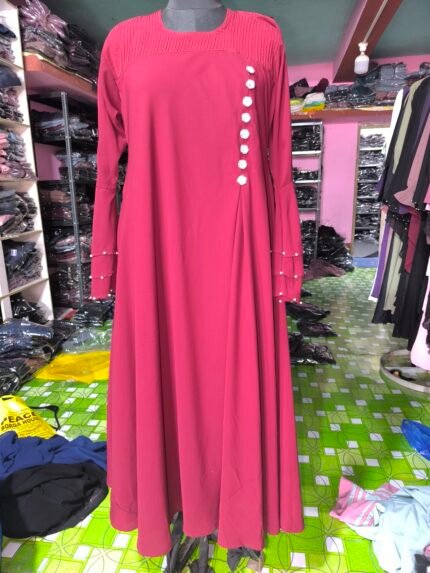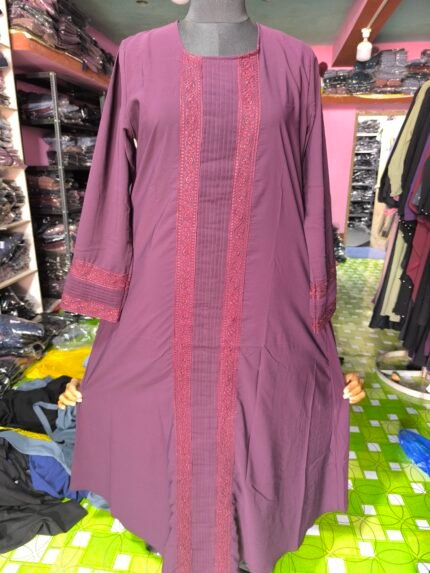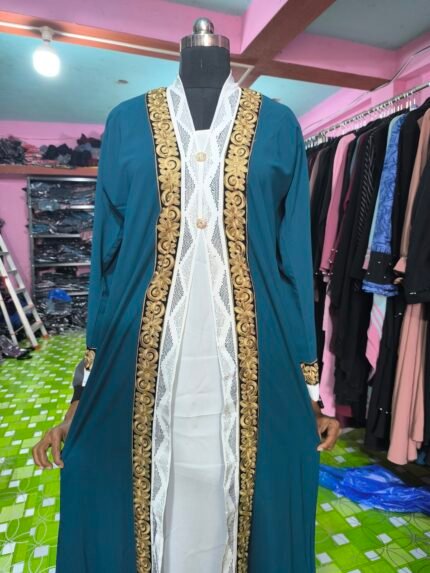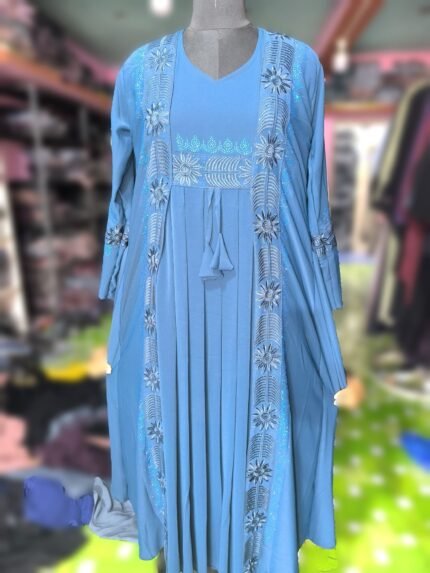Abaya Burqa in Two Layers with a Shrug Attached-2024
Burqa-This two-layered abaya will enhance your outfit. It’s a perfectly wearable ensemble with a touch of flair for daily wear. It goes well with our selection of shrugs or can be worn alone.
PRODUCT SPECIFICATION

Full Sleeves
Dual Layer
Round Neck
One Side
FABRIC: Nida Matte
FIT: Slim Fit
SIZE: Model is wearing a S size
Model Height: 6 Feet
WASH CARE: Use a cold water machine. See the included wash care label for further information.
The product’s actual colour may differ significantly depending on your device or the photographic lighting sources.
The Muslim Closet Dual Layer Shrug is now available. Abaya dress for women and girls who value traditional style with a contemporary touch, made of fine quality Nida matte fabric. The distinctive dual-layer shrug on this abaya dress gives your entire appearance an extra dose of sophistication and elegance.
This abaya dress is made of lightweight, breathable Nida matte fabric, making it easy to wear all day. In addition, the dress has side pockets, which are great for holding little items.
It’s crucial to remember that this dress’s two layers are joined and cannot be worn apart.
Fit: Loose Fit; please see our sizing chart for details.
The package includes a single dress, devoid of any other accessories that may be depicted in the picture(s).
The burqa has its roots in various cultural practices, predating Islam. In many Middle Eastern societies, modest dress has been a part of the social fabric for centuries. The introduction of Islam in the 7th century brought new dimensions to modesty guidelines, and the burqa emerged as one interpretation of these teachings. It is most commonly associated with Afghan women, especially in regions governed by conservative interpretations of Islamic law.
Cultural Significance
For many women, wearing the burqa is not merely a religious obligation but a personal choice that reflects their cultural identity. In some communities, it symbolizes dignity and respect. Women may feel empowered by their decision to wear it, viewing it as a way to assert their faith and individuality. In this sense, the burqa can be seen as a protective garment, providing a sense of security and a barrier against the outside world.
Contemporary Debates
In recent years, the burqa has also become a focal point in discussions about women’s rights and freedom of expression. Critics argue that it can symbolize oppression, suggesting that women who wear it are forced into submission. Proponents, however, contend that choice is paramount; they argue that many women voluntarily wear the burqa as an expression of their faith and autonomy. This divergence of perspectives has sparked heated debates in various countries, leading to legislation that bans or restricts the garment in public spaces.
Global Perspectives
The perception of the burqa varies significantly from one country to another. In France, for instance, the government implemented a ban on full-face veils, citing secularism and security concerns. Conversely, in countries like Saudi Arabia and Afghanistan, wearing the burqa is often mandated. Such contrasting approaches highlight the complex interplay between cultural values, legal frameworks, and individual freedoms.
Challenges and Misunderstandings
One of the challenges surrounding the burqa is the tendency for it to be misunderstood by those outside the culture. Media portrayals often reduce the narrative to one of victimhood, overlooking the voices of women who embrace the burqa as a symbol of pride. This misrepresentation can lead to broader societal misunderstandings and reinforce stereotypes about Muslim women.
Conclusion
The burqa remains a potent symbol, encompassing a variety of meanings that reflect the intricate tapestry of cultural, religious, and personal narratives. While it can evoke strong reactions—both supportive and critical—it is essential to approach the topic with nuance and respect for individual choices. Ultimately, the discussion surrounding the burqa is not merely about the garment itself but rather about the broader issues of identity, autonomy, and the rights of women in diverse societies. By fostering dialogue and understanding, we can appreciate the complexities surrounding this significant piece of clothing and the women who wear it.










Reviews
There are no reviews yet.